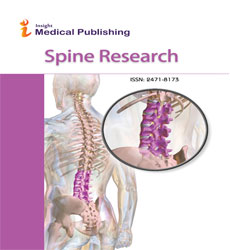Biomechanics of the Spine: Implications for Injury Prevention and Rehabilitation
Aisyah Nurul
Published Date: 2025-02-28Aisyah Nurul
Department of Neurosurgery, University of Pennsylvania Perelman School of Medicine, Philadelphia, PA 19104, USA
*Corresponding author:
Aisyah Nurul,
Department of Neurosurgery, University of Pennsylvania Perelman School of Medicine, Philadelphia, PA 19104, USA,
E-mail: nurul.aisyah@pennmedicine.upenn.edu
Received date: February 01, 2025, Manuscript No. ipsr-25-20624; Editor assigned date: February 03, 2025, PreQC No. ipsr-25-20624 (PQ); Reviewed date: February 15, 2025, QC No. ipsr-25-20624; Revised date: February 22, 2025, Manuscript No. ipsr-25-20624 (R); Published date: February 28, 2025, DOI: 10.36648/ 2471-8173.11.1.01
Citation: Nurul A (2025) Biomechanics of the Spine: Implications for Injury Prevention and Rehabilitation. Spine Res Vol.11 No.1:01
Introduction
The human spine is a complex and highly specialized structure that provides structural support, enables flexibility and mobility and protects the spinal cord and associated neural elements. Composed of vertebrae, intervertebral discs, ligaments, muscles and joints, the spine functions as both a rigid and dynamic framework capable of withstanding mechanical loads while permitting a wide range of movements. Understanding spinal biomechanics is essential for preventing injury, optimizing physical performance and designing effective rehabilitation strategies for musculoskeletal disorders. Abnormal mechanical stresses, improper movement patterns, or structural deficits can contribute to acute injuries, chronic pain, degenerative changes and neurological complications. Advances in biomechanical research have enhanced the understanding of spinal load distribution, kinematics and tissue mechanics, providing critical insights for clinicians, therapists and ergonomists aiming to preserve spinal health and restore function [1].
Description
Spinal biomechanics involves the study of forces, motions and structural responses of the vertebral column under physiological and pathological conditions. The spine is divided into cervical, thoracic, lumbar, sacral and coccygeal regions, each with distinct anatomical and mechanical characteristics. The cervical spine supports head mobility and weight, the thoracic spine provides stability and rib articulation and the lumbar spine bears the greatest mechanical loads, making it particularly susceptible to injury. Intervertebral discs act as shock absorbers, distributing axial loads and allowing flexibility, while facet joints guide and limit spinal motion. Ligaments and musculature provide passive and active stabilization, respectively, maintaining spinal alignment and protecting neural structures [2].
Mechanical loads on the spine can be categorized as axial compression, tension, shear and torsion and bending moments. Axial compression occurs during weight-bearing activities and is countered primarily by intervertebral discs and vertebral bodies. Shear forces, which act parallel to the disc plane, are resisted by disc annulus fibrosus and ligaments. Torsional forces, resulting from rotational movements, place stress on facet joints and surrounding ligaments. Excessive or repetitive loading beyond physiological limits can compromise spinal structures, leading to disc herniation, ligament sprains, vertebral fractures, or facet joint degeneration. Biomechanical studies utilizing cadaveric models, finite element analysis and in vivo imaging have quantified load distribution and tissue responses, enabling precise assessment of injury mechanisms [1].
Spinal kinematics, including flexion, extension, lateral bending and rotation, are governed by the interaction of vertebrae, discs, ligaments and musculature. Movement in one spinal region affects adjacent segments due to coupled motions and intersegmental load sharing. Altered kinematics, such as hypermobility, hypomobility, or abnormal segmental motion, can increase stress on specific spinal tissues, contributing to overuse injuries or chronic pain syndromes. For example, limited lumbar flexion during lifting tasks may transfer excessive load to the thoracolumbar junction, predisposing to disc or ligament injury. Understanding these motion patterns is essential for designing preventive exercises, ergonomic interventions and rehabilitation protocols [2]. Muscle activity plays a central role in spinal biomechanics by providing dynamic stabilization and controlling movement.
Core musculature, including the multifidus, erector spinae, transverse abdominis and oblique muscles, forms a functional corset that maintains vertebral alignment and dissipates mechanical stress. Dysfunction, atrophy, or delayed activation of these muscles can result in instability, abnormal loading and increased risk of injury [1]. Electromyographic studies have demonstrated that coordinated muscle activation patterns are critical during lifting, bending and rotational tasks, highlighting the importance of neuromuscular training in injury prevention and rehabilitation. Ergonomics and load management are key applications of spinal biomechanics in preventing injury. Occupational tasks involving repetitive lifting, prolonged static postures, or awkward spinal positions contribute to cumulative mechanical stress and musculoskeletal disorders. Biomechanical modeling has informed safe lifting techniques, including optimal trunk posture, load distribution and movement velocity, reducing the incidence of low back injuries. Similarly, ergonomic adjustments in workstations, seating and manual handling practices minimize shear and compressive forces on the spine, preserving tissue integrity over time [2].
Conclusion
The biomechanics of the spine underpin its structural integrity, functional mobility and capacity to withstand mechanical stress. Understanding spinal load distribution, kinematics and muscle function and tissue mechanics is essential for preventing injury, optimizing performance and guiding rehabilitation. Abnormal mechanical stress, poor posture, repetitive movements and muscular dysfunction contribute to acute injuries, chronic pain and degenerative changes. Biomechanically informed strategies including ergonomic interventions, core stabilization exercises, movement retraining and progressive rehabilitation enhance spinal resilience and support recovery. Technological advancements in motion analysis, finite element modeling and imaging facilitate precise assessment and personalized intervention. Integrating biomechanical principles into clinical practice, occupational health and athletic training promotes spinal health, reduces injury risk and improves long-term functional outcomes, emphasizing the critical role of biomechanics in preventive and rehabilitative care.
Acknowledgement
None.
Conflict of Interest
None.
References
- Kjaer P, Leboeuf YC, Korsholm L, Sorensen JS, Bendix T (2005) Magnetic resonance imaging and low back pain in adults: A diagnosis Imaging study of 40-year-old men and women. Spine 30: 1173-1180.
Google Scholar Cross Ref Indexed at
- Modic MT, Masaryk TJ, Ross JS, Carter JR (1988) Imaging of degenerative disk disease. Radiology 168: 177-186.
Google Scholar Cross Ref Indexed at
Open Access Journals
- Aquaculture & Veterinary Science
- Chemistry & Chemical Sciences
- Clinical Sciences
- Engineering
- General Science
- Genetics & Molecular Biology
- Health Care & Nursing
- Immunology & Microbiology
- Materials Science
- Mathematics & Physics
- Medical Sciences
- Neurology & Psychiatry
- Oncology & Cancer Science
- Pharmaceutical Sciences
